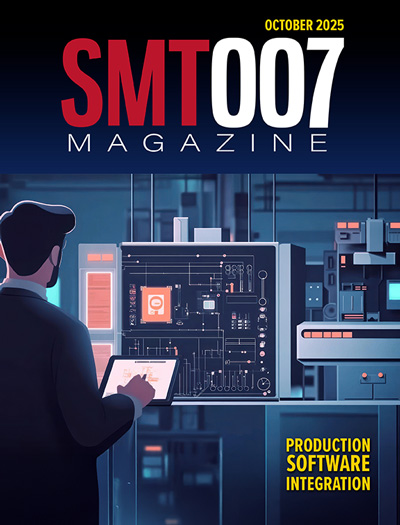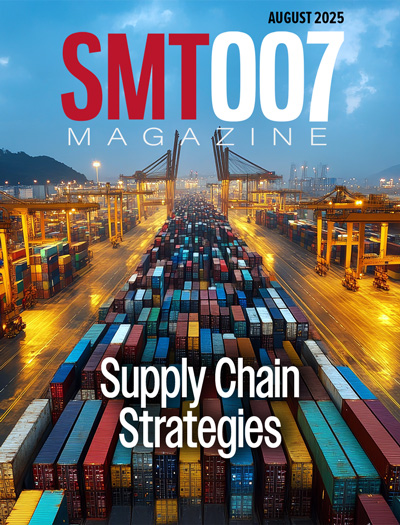-

-
News
News Highlights
- Books
Featured Books
- smt007 Magazine
Latest Issues
Current Issue
Production Software Integration
EMS companies need advanced software systems to thrive and compete. But these systems require significant effort to integrate and deploy. What is the reality, and how can we make it easier for everyone?

Spotlight on India
We invite you on a virtual tour of India’s thriving ecosystem, guided by the Global Electronics Association’s India office staff, who share their insights into the region’s growth and opportunities.

Supply Chain Strategies
A successful brand is built on strong customer relationships—anchored by a well-orchestrated supply chain at its core. This month, we look at how managing your supply chain directly influences customer perception.
- Articles
- Columns
- Links
- Media kit
||| MENU - smt007 Magazine
Estimated reading time: 2 minutes
Contact Columnist Form
Happy’s Tech Talk #37: New Ultra HDI Materials
Some new materials have been introduced in the past year for ultra high density interconnect (UHDI), a convenient title for developing high density technologies. They have received labels like semiconductor-like PCBs (SLPs), redistribution layers (RDL), flip-chip ball grid array (FCBGA), and interposers.
The early 2000s saw the creation of these organic substrates for flip-chip IC packaging. The initial construction was composed of a BT core with build-up layers of the Ajinomoto Build-up Film (ABF) (Table 1).
First UHDI Material
Engineers perfected the first high-volume flip-chip organic packaging using new vacuum-laminated thermoset resin films from Ajinomoto (Table 1) in densities of 8–12-micron traces/spaces. The larger geometries of 25–75-micron t/s used more conventional thin laser drillable (LD) laminates, prepregs, and resin-coated foil (RCC/RCF)1. Because controlled impedance is required for these boards, many new UHDI materials are unreinforced resin films, such as the one shown in Figure 1.
Newer UHDI Materials
Besides new RCCs and RCFs, there are supported film and liquid resins that provide bonding for various thin build-up dielectrics.
Newer UHDI materials are from AGC Multi-Material America Inc. Tables 2 through 62 present some of the thin materials. The AGC products start with various thin copper foils from 1.5, 2, 3, 5, up to 18 microns, as seen in Table 2.
These five thin copper foils are on the fastRise™ TC/HF and X unsupported resin films (Tables 3 and 4).
Like many PCB laminate suppliers, AGC has several thin-core laminates with spread glass fabrics, as seen in Table 5. These use reduced glass yarn and threads, resulting in thinner cores and prepregs1,3:
- 1015: 0.014 mm
- 1027: 0.020 mm
- 101: 0.024 mm
- 1037: 0.033 mm
- 106: 0.033 mm
- 1067: 0.035 mm
- 1078: 0.043 mm
- 1080: 0.053 mm
- 1086: 0.054 mm
AGC has also compared its build-up films with other UHDI films for warpage/bow across large panels. Minimizing warpage is important for the larger mega-module BGAs of AI and HPC (Table 6).
Other UHDI Materials
Other laminate manufacturers have thin product lines of supported resins (Dicy-Phenolic-Halogen-free and polyimides)3 like Ventec’s Bondply and RCCs, as seen in Figure 2.
Summary
The need for UHDI programs is great. I saw this need at the IPC High Density PWB Conference at IPC APEX EXPO 2024, and SMTA’s UHDI Pavilion last October. The next step is to tie our HDI and UHDI manufacturing processes to the new IPC HDI design standards and IPC UHDI design standards.
References
- The HDI Handbook, Chapter 5, “HDI Materials.”
- SMTA 2024 Technical Knowledge, UHDI Symposium (April 2024) and UHDI Pavilion (October 2024)
- “Happy’s Tech Talk #29: Bend-to-Install Semi-flex FR-4,” by Happy Holden, PCB007 Magazine, May 2024.
Happy Holden has worked in printed circuit technology since 1970 with Hewlett-Packard, NanYa Westwood, Merix, Foxconn, and Gentex. He is currently a contributing technical editor with I-Connect007, and the author of Automation and Advanced Procedures in PCB Fabrication, and 24 Essential Skills for Engineers.
This column originally appeared in the January 2025 issue of PCB007 Magazine.
More Columns from Happy’s Tech Talk
Happy’s Tech Talk #43: Engineering Statistics Training With Free SoftwareHappy’s Tech Talk #42: Applying Density Equations to UHDI Design
Happy’s Tech Talk #41: Sustainability and Circularity for Electronics Manufacturing
Happy’s Tech Talk #40: Factors in PTH Reliability—Hole Voids
Happy’s Tech Talk #39: PCBs Replace Motor Windings
Happy’s Tech Talk #38: Novel Metallization for UHDI
Happy’s Tech Talk #36: The LEGO Principle of Optical Assembly
Happy’s Tech Talk #35: Yields March to Design Rules


